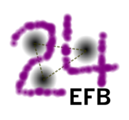Speaker
Description
The current paradigm to describe the nuclear interaction is within the frame of Chiral Effective Field Theory (χEFT) which organizes contributions to nuclear observables in a series of decreasing importance. Within this framework the leading contribution already requires to solve exactly the many-body Schrödinger equation with a particular Hamiltonian. Nevertheless, such calculations are numerically intractable for A-body observables whenever A ≫ 10.
Consequently, following the EFT program to describe infinite nuclear matter, and in particular its Equation of State (EoS), appears to be challenging. In this talk I will focus in particular on Many-body Perturbation Theory (MBPT) and more generally on many-body approximations that can be expressed as a sum of perturbation diagrams. Such additional approximations depart from the original EFT program. The goal of this talk is thus to emphasize the impact of many-body approximation on the renormalization invariance of many-body observables. I will also present new formal developments that pave the way to a systematic approach for renormalization-invariant many-body calculations. In practice, these developments could lead, in the near future, to a reduction of systematic theoretical uncertainties of nuclear many-body observables.

